#The Hecataea
Text
Who are The Hecateae?
In issue 2 Neil Gaiman’s The Sandman we are introduced to a trio of witches known as The Hecateae. Someone in my Sandman Facebook group asked me about them. Part of why you might not know who they are is because Neil accidentally invented a new spelling for the name.
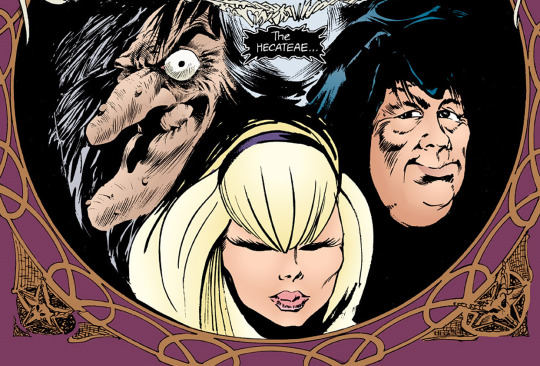
The original spelling should probably have been Hecataea. It all originates with Hecate, the Greek Goddess of magick and witchcraft. In modern neo-Paganism the concept of the Triple Goddess is very popular. Maiden, Mother, and Crone.
Their sigil is usually the waxing, full, and waning moon respectively.

Neil Gaiman uses the Maiden, Mother, and Crone a lot in The Sandman. With the Hecataea, and Eve, for example. Eve can transform to a Maiden form, Mother, and Crone. And the story behind this is told in issue 40 of The Sandman, A Parliament of Rooks. The story talks about how Adam may have had three wives, or they may have all been the same woman. And how “both” are true.
Three women, as a powerful magical force, is popular in folklore and mythology. There’s also The Fates of Greek Mythology, and the Furies AKA The Kindly Ones. The Norse had The Norns. In The Sandman Neil treats them all as aspects of the same entity.
When Morpheus summons The Hecataea in issue 2 of The Sandman “Imperfect hosts” he refers to them as Clotho, Lachesis, and Atropos. This is the name of the Fates (Moirai) in mythology. However these characters answer to Cynthia, Mildred and Mordred (Sometimes corrected to Morgan or Morgain). This is because The Three Witches used these names in their own horror anthology comic “The Witching Hour.” Nearly every character introduced in The Sandman issue 2 was an old horror anthology comic host. The title of the issue was a pun. “Imperfect hosts.”
The horror hosts introduced in this issue are Cain, Abel, Lucien, The Three Witches (The Hecataea), Eve (Also known as The Raven Woman), The Mad Mod Witch (Fashion Thing), and Destiny (now Destiny of The Endless). Cain, who began as DC’s equivalent to EC’s The Crypt Keeper, hosted The House of Mystery. Abel hosted The House of Secrets. Lucien hosted Tales of Ghost Castle (which is retroactively Morpheus’s castle in The Sandman). The Three witches hosted The Witching Hour. You get the idea.
But before they were even horror hosts, the trio was an architype common in folklore and popular culture. You will find that in most works of folklore and fiction if it’s not a witch acting alone, she’s usually in a coven of three. They’re not literally a Maiden (virgin or child-like), Mother, and Crone. Sometimes they just fit the physical appearance or personalities heavily associated with these concepts.
A popular famous example of this is Disney’s Hocus Pocus. Winifred, the leader, is the Crone of the group as she is the leader and most cantankerous. She’s also the eldest sister. Mary, the middle sister, is a bit heavier and is maternal toward her sisters. She loves food and loves to cook and care for her siblings. This is the mother. And Sarah (though not virginal) is the most child-like. Much like Cynthia in The Hecataea, she is surprisingly sensual and a bit dim.

Another good example is Terry Pratchett’s Wyrd Sisters who served as a parody on the trope, particularly from Shakespeare’s famous play.
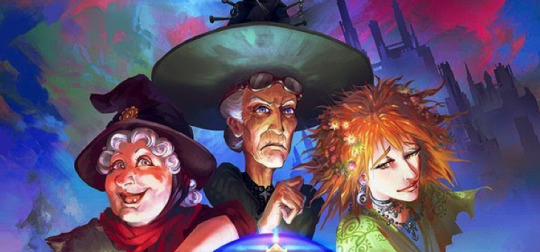
Disney’s Gargoyles even had a version of The Sisters. In that continuity they are of Oberon’s court, meaning that they are fae folk. But much like The Endless in Neil Gaiman’s The Sandman their appearance changes based on who is addressing them. Goliath and his clan of Gargoyles saw them as human children. Demona saw them as woman Gargoyles (as she does not like or trust humans). MacBeth saw them as human women.


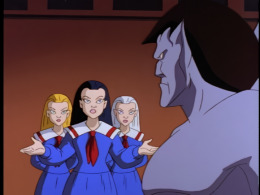
There’s also the Hex Girls in Scooby Doo and The Witch’s Ghost.

A helpful version of the three appear in the Fairy tale The Three Spinners where, like Rumpelstiltskin, they aid a girl who is forced to spin for a king.
Once you start to notice it, you realize the three turn up a lot in pop culture. It’s also common in religion. In Christianity there’s The Father, son, and Holy Spirit. Goethe’s Faust has Pagan roots despite its use of demons, Angels, and God. In fact the entity at the end may well be the Triple Goddess as she is referred to as “Virgin, Mother, and now Queen. Goddess grant your mercies.” - A. S. Kline translation of Goethe’s Faust Part 2. It’s no surprise that this also fits the Virgin Mary. A Maiden and a Mother, and also Queen (as opposed to Crone).
Note: Sometimes the Maiden, Mother, and Crone are actually referred to as Maiden, Mother, and Queen as it’s considered more respectful.
In The Sandman, at one point, Morpheus refers to the three-in-one as Witch Queen.

Again, this is because of the roots with Hecate, Goddess of Magick and spells. The neopagan popularity of The Triple Goddess also helps perpetuate the archetype. Almost every witch coven has three (sometimes four) members. Three is considered the sacred number. And once you notice it, you’ll start to see the Maiden, Mother, and Crone in a lot of things.
I will also point out here that though it’s popular to consider Midnight The Witching Hour, the actual traditional Witching Hour is three AM or as Ray Bradbury called it in Something Wicked This way Comes, The Soul’s Midnight.
Neil Gaiman takes the Hecataea and also uses The three-in-one for The Furies AKA The Kindly Ones.
80 notes
·
View notes
Text
Hekate

One of the lesser-known deities in the Greek pantheon is Hecate. Being the only Titan to maintain her authority under Zeus' rule, she was the child of Perses and Asteria. The limits of the heavens, the earth, the oceans, and the underworld were not able to contain Hecate's might.
The stories surrounding the goddess Hecate tell us a lot about her domains of influence even if there aren't many myths about her. Many of her characteristics were associated with the underworld in the time of the Romans. But she also had power over things that positioned her squarely in the spotlight. The goddess held great abilities that other gods eventually adopted. Hecate could provide money and benefits to those who worshipped her, but she could also withhold these gifts from those who did not honour her sufficiently. This essay will examine the characteristics and emblems of Hecate.
The origins of Hekate:
Classicalists disagree over where the worshippers of Hecate came from in ancient Greece. There are many who trace the origins of goddess worship back to pre-Greek times, while others trace it back to Thrace. The most widely recognised theory is that Hecate came from the Carians in Asia Minor and was incorporated into Greek religion. Scholars say that the deity is said to have arrived in Greece in the Archaic period. The quantity of cult sites devoted to the goddess Hecatean attests to the adoration of the goddess in Caria. These were particularly noticeable in Lagina. Nonetheless, other classicists contend that the goddess cannot have an Anatolian origin because of the late dates of these Anatolian worship sites.
According to historical accounts, Hecate initially appears in the seventh century BCE in Hesiod's Theogony. Hesiod just makes reference to her parents and her part in the Gigantomachy, in which she slew Clytius. She is noticeably missing from the Homeric epics, though.
The most famous literary appearance of Hecate is perhaps her portrayal in the Homeric Hymn to Demeter. Hecate and the sun god Hyperion hear Persephone's screams as Hades kidnaps her in the song. Hecate appeared to Demeter on the tenth day, holding a lamp, after she had been looking for her daughter for nine days.
The goddess did not know who had abducted her daughter, but she informed Demeter what she had heard. Hecate gave Persephone a hug once she was reunited with Demeter. When Persephone went back to Hades every year, she would become her underworld companion. One common iconography associated with this narrative is Hecate holding a torch.
Her divine duties:
In Greek religion, Hecate was entrusted with a wide range of heavenly responsibilities. She was most famously the goddess of the moon, sorcery, witchcraft, darkness, light, and ghosts. She was also the goddess who guarded entranceways and oikos.
As a triple goddess, Hecate was closely connected to the intersection. She was described as a liminal deity with effortless passage from the underworld to the outside world. Her ability to transition between her roles as a goddess and a Titan came from her mythology and lineage. Her cult names and epithets, such as Propylaia (of the gates), Trodia (frequenter of the crossroads), and Enodia (on the path), witness to her liminality.
Lucan's Pharsalia had solidified Hecate's status as a goddess of witchcraft and sorcery by the first century CE. In the Pharsalia, the witch Erichtho calls upon Persephone, the lowest manifestation of Hecate. We discover the hag-like characteristics bestowed to Hecate in the Pharsalia.
Ghosts and Lampades, or nymphs of the underworld, were part of her entourage. Legend has it that Zeus gave Helen the Lampades as a present for her allegiance to him during the Titanomachy. The goddess goes at night with the Lampades, who bear lamps.
Depictions of the goddess:
Greek ceramics frequently featured Hecate as a single figure, dressed in a long gown, clutching torches. At intersections and gateways stood the pillars of Hecataea, the goddess of torch-bearing. Later, the most common iconography of Hecate shows her as a triple-formed goddess, each form standing behind the other and facing a different way at a crossroads.
She added the Graces dancing around the goddess, like in the top image, to some of her sculpture votive offerings. She is accompanied by a pack of dogs in some depictions. Pausanias claims in his Description of Greece that Alcamenes, a sculptor, was the first to show Hecate in her triple-form about the fifth century BCE. He adds that next to Wingless Victory's temple on the Acropolis in Athens was a sculpture of the goddess Hecate Epipurgidia (on the tower).
Hecate is shown as trimorphic on the well-known Pergamon Altar (c. 2nd century BCE), battling a monster that resembles a snake with the aid of a dog. Hecate's triple form was shown as three distinct bodies around a central column throughout antiquity. However, this depiction changed into a single goddess with three heads in late antiquity. Hecate is described as having three heads in esoteric literature from this era: the heads of a dog, a serpent, and a horse. Hecate was also associated with other deities from neighbouring pantheons.
Connectivity With Artemis:
Hecate, also known as Ἑκατη, is derived from the Greek term hekatos, which means "worker from afar." One of the most prevalent epithets for Apollo is the male version, Hekatos. This Apolline epithet, according to researchers, associates Hecate with Artemis, a goddess with comparable realms of power. The goddesses had many of the same characteristics.
In most depictions, both goddesses were seen with dogs, holding torches, and dressed in hunting boots. Frequently, they were combined to create a twin goddess, as seen in Aeschylus' Suppliants. The chorus in Aeschylus' play refers to the two goddesses as one. The goddesses are once again consolidated in Aristophanes' Frogs (1358f), when the goddesses are called upon by the figure of Aeschylus.
Connectivity with Artemis-Selene:
Hecate was combined with the goddesses Artemis and Selene throughout the Roman era, especially in Roman poetry. She was referred to by her Roman name, Trivia, in addition to her combined triple form. By referring to Hecate as Hecate-Selene and other such monikers, the Roman authors fostered her trimorphic representations. Seneca makes many references to Hecate along with her lunar equivalents, even drawing a connection between the goddess and Medea.
Connectivity with Iphigenia
Hecate was identified by early ancient accounts as the daughter of Agamemnon, Iphigenia. Pausanias quotes Hesiod as saying that Artemis's will transformed Iphigenia into Hecate, not killing her. Hecate was sometimes identified in this way with a deity known to the Tauri as Iphigenia.
Connectivity with Hermes:
Hecate was identified as the wife of this chthonic Hermes in many ancient traditions. Hermes also had chthonic features. Being gods of the dead, Hecate and Hermes were able to cross borders and liminal zones between realms. First appearing in the first century BCE, the Roman poet Propertius proposed a link between these two gods.
Hekate's sacred animals:
The dog was Hecate's most holy animal, as was previously indicated. The sound of dogs barking from the underworld is described by Apollonius of Rhodes as accompanying Hecate.
Pausanias and Ovid, two ancient writers, mention that dogs, especially black canines, were offered as sacrifices to the goddess. Additionally, scholars have proposed that Hecate's connection to dogs is indicative of her function as a goddess of birth. This is so because other birth goddesses, such Eileithyia and Genetyllis, also revered dogs as their holy animals.
Hecate's hounds were later connected to the restless spirits of the deceased that followed the goddess in antiquity. Queen Hecuba's transformation into a dog is associated with the goddess Hecate. After Troy fell, so the tradition goes, Odysseus took Hecuba as a hostage. But while travelling to Greece, the Trojan queen slew a Thracian king. Hecuba was punished by being changed into a black dog, which she later adopted as a pet.
The polecat, or weasel, was another animal considered sacred by the goddess Hecate. In the mythology recounted by Antonius Liberalis, Galinthias, Alcmena's midwife, tricked the gods when Heracles was born. Galinthias went to the goddess of childbirth, Eileithyia, after observing Alcmena experiencing labour pains. The Fates informed them that the child had been delivered and had prolonged the labour as a favour for Hera. Galinthias became a polecat in punishment for tricking the gods. Galinthias was chosen by Hecate, who felt sorry for her change, to be her friend and attendant.
Honouring the Goddess Hecate:
In mainland Greece, the worship of other Olympians was more common than the cult of the goddess. In the ancient world, the goddess had a small number of temples devoted to her. In the past, smaller home shrines dedicated to Hecate were typical. These little shrines were built to fend off evil and shield the person from sorcery. The three most important Hecate worship sites in Greece were on the island of Samothrace, in Caria, and in Eleusis.
The goddess was revered as a deity of the mysteries in Samothrace. Her worship has also been documented at Athens, Colophon, Thrace, and Thessaly. Dog sacrifices made in the goddess' honour have been documented in the last two cities. According to Pausanias, Hecate was the goddess most revered by the Aegina people, who thought Orpheus had instituted the goddess's ceremonies on the island. Pausanias also mentions a wooden representation of Hecate that is housed in the temple of Aeginetan.
Hecate has many Orphic Hymns, but no Homeric Hymn dedicated to her. Actually, a song honouring the goddess starts the collection of Orphic Hymns. Her significance stems from her function as a goddess of entrances. Many details concerning Hecate's realms of influence as understood by the Orphics may be found in the Orphic Hymn to Hecate. She was invoked as the goddess of highways and crossroads in their mysteries.
Most notably, she is also called the goddess of the dead, who presides over deserted places. In this hymn, her sacred animals include deer, dogs, and wild predators. She is described as the herder of bulls and a nurturer of youths, as well. The hymn beseeches the goddess to come to the holy rites in a favorable mood with a happy heart.
The more we discover about the goddess Hecate, the more fascinating she appears to be. Her role as a guardian is highlighted by her roles as a liminal figure and a goddess of pathways and entrances. However, her evil side is revealed by her function as a nighttime goddess of sorcery and witchcraft. Hecate is a complex character who merits consideration on par with the more well-known Greek pantheon gods.
Zeus granted Hekate jurisdiction over land, sky, and water (underworld). This was either given to her to aid the Olympians in their fight against the titans (her own "people") or after the event was completed.
It wasn't "her power can't be contained"; she was shown to be worthy of the realms.
She was always a deity of witchcrafts and necromancy in ancient Turkey, but when the Romans came in, they kind of wiped off her necromancy features.

Offerings to give to her:
Edibles-
Breads - i personally give her garlic bread
Cakes
Pomegranates
Wines
Honey
Cinnamon
Garlic
Onion
Milk
Chocolates
Non edibles-
Roses
Lavender
Poppy seeds
Dandelions
Blood: If you have ever battled with self-harm of any type or are easily nauseated at the sight of blood, DO NOT ATTEMPT. She cherishes your mental health and well-being more than anything you could ever offer it to her, and Hekate understands that you cannot give Her your essence! She is going to adore and defend you no matter what!
Incense she likes-
Frankincense
Lavender
Jasmine
Citrus - especially orange
Dragons Blood
Other-
keys *
Candles
Tea Lights
Bones
Fires - i.e. bonfires *
Oil lamps
Lavender *
Crow/Raven/Owl Feathers - only feathers naturally fallen off
Statues of Her and Her sacred animals *
Poetry, literature, and music you heavily associate with Her **
Witchraft books, spell books, dedicate any shadow work to her
Devote things to her-
Give food, clothing, toiletries, and other necessities to homeless shelters.
Visit cemeteries and, if permitted (please inquire beforehand), place flowers on the graves
Possess a plush toad, dog, or polecat.
Devote a meal or self care to her!
Give to the less fortunate. If you see a homeless person, get them a hot meal and a hot drink ect. Say a prayer to her before you do it
Share some tea with her or have a cup with her
Adding onto the sharing tea, sit at her altar with the tea and some cake. Talk to her, tell her about your day or ask her about hers
Do some baking and share what you baked
#pagan witch#witch#witchblr#witchcore#witchcraft#beginner witch friendly#hekate#hellenic#deity work#deity worship#hekatean witch
47 notes
·
View notes
Text
The title screen theme for Hemotropic Friendship Virus: Occultation. This is Ximun's character theme, except a little more ambitious!
#hemotropic friendship virus: occultation#renpy game#vndev#songs#hfv: occultation#hemotropic friendship virus
0 notes
Photo

"She who works from afar,” Hekate, is one of my Patron Goddess's. Hekate governs over the crossroads, magic, ritual and spells. Not to mention Hekate works with the household, everything to do with newly born anything, Keeper of the Keys and a much longer list that would require its own post. In my work, especially custom work, the Dark Mother has been working with us. The Crossroads have been at the forefront of this years work and quite honestly many years for me but I was not in a position to receive that work and message. Now, it is clear. We grow when we can face our mirrors. Facing evil. Facing fears. Facing hope. Facing opportunity. Facing ourselves. So many have been touched by her purpose and resolve. The Hecataea are the Pillars that stand at the crossroads and in doorways to keep away evil spirits and ward off anything that hopes to be caustic to your person. And in this work, in this way, the Dark Mother comes to me. Standing tall, honest, powerful and not blinded by false idols. While working over the past eight months or so, I have been creating as I always do but there was an incense that I made that I was able to do Shadow Work with but also, any work. I create while it embraces my space and home. I journeyed with this offering on two different occasions and went to the crossroads each time. On both occasions, I was met with important knowledge and from there, I made the biggest decisions I have had to make in a long time. 2020 birthed this incense, Hecataea, The Pillars at the Crossroads. The ward and the truth. The Guardian, the Titan and the Mirror. Doing our work is to dismantle ourselves. It is to rebuild from the bones up and to forcefully take apart ego and self infestation of pride through our own means. Actively participate in your own This, this most devotional incense will be available during our next update on February 26th at 7PM EST on our Etsy Shop. Link is in the bio✨ · · · · #maidenandcrow #maidenandcrowapothecary #maidenandcrowritual #themagician #traditionalwitchcraft #witchcraft #witchesofinstagram #witchshop #witchcommunity #maidenandcrowspiritual #maidenandcrowspiritualapothecary #hekate #hecataea #etsy https://www.instagram.com/p/CLkgGZXht8q/?igshid=bc41i0bx3qqg
#maidenandcrow#maidenandcrowapothecary#maidenandcrowritual#themagician#traditionalwitchcraft#witchcraft#witchesofinstagram#witchshop#witchcommunity#maidenandcrowspiritual#maidenandcrowspiritualapothecary#hekate#hecataea#etsy
0 notes
Note
What was your first story about?
You're gonna need to be more specific. When you say "First Story" do you mean the My Little Pony fanfic I dictated to my mom when I was 4? Or the 276 page novel I pumped out in freshman year of high school because I was amped up on methylphenidate?
...I'm going to assume the latter because I remember more of that one.
It was a story about a war between two city-states. Countries? I referred to them largely as cities with plenty of wilderness between them and I called the setting "neo-greek steampunk" but that basically translated to "Jak and Daxter/Jak II levels of technology but also there's little greco-roman elements thrown into everyone's outfits but also the clothing is essentially modern." I was aesthetically ALL OVER THE PLACE.
The antagonistic city, Hecataea ("I'm so clever" said 14-year-old me) had this training program where children were basically trained in harnessing and weaponizing magic from early childhood. Theova "Theo" Locke, my main character from the more technologically-driven City-state of Aerithae, was sent in by her father Silas (Who, reading my own writing I realize I basically wrote a Gendo Ikari before I even knew what Neon Genesis Evangelion was) into this fucked-up training program to learn everything they could about the enemy's tactics. Theo also had a loyal and protective (and kind of fussy) fairy friend Avari even though I never really explained the presence of fairies in this world. Theo was absolutely a Daddy's girl though and was absolutely unflinchingly loyal to her father, but in the midst of this fucked up magical training program behind enemy lines, she made a close friend, Aleric. Eventually Theo and Silas had to return to Aerithae. But then Theo and Aleric made a promise to stay alive and find each other when the war was over. Fast forward a couple years, and.... oop. They're both fighting for their respective cities.
There was drama! There was espionage! There was a whole subplot about a sword talking to a guy inside his brain and telling him to be fucked up and evil! Everyone had daddy issues! There was childhood friendship romantic tension! There was so much inconsistent characterization oh my god it physically pains me to read some parts, but other parts I can see that my 14 year old self was "Fuck cops and fuck occupying forces" and I'm proud of her for that. Eventually the story ended with the revelation that Silas wasn't Theo's biological father, and he was intending to use the fucked up evil magic sword to make... basically nukes, Theo punched him out and Avari sacrificed himself to disable the bombs, but Theo and all her friends got arrested. So I was kind of planning to turn the whole thing into a saga, but I think I only made it 178 pages into the sequel (they get out of prison and start on a quest across the land but I ended up losing a lot of steam once the team broke up) before I got a completely different idea, switched gears hard, and wrote a 400 page novel about something completely unrelated.
Honestly though, looking back I really loved some of my funky little worldbuilding concepts. I had airships (I couldn't not have airships), people were using swords and crossbows just as much as they were using guns (Hell, Theo had a spear because I thought polearms were the coolest weapons), and instead of phones people had these things called "Portable Lantern Comms" or "PLC's" that they would drop scraps of paper into the flames and the words would appear in someone else's flames. And also... they could be... hacked??? There was like... a Lantern Internet??? 14 year old me was just beginning to learn how to worldbuild, but I gotta admit I like her moxie.
49 notes
·
View notes
Text
Magickal Correspondences: August
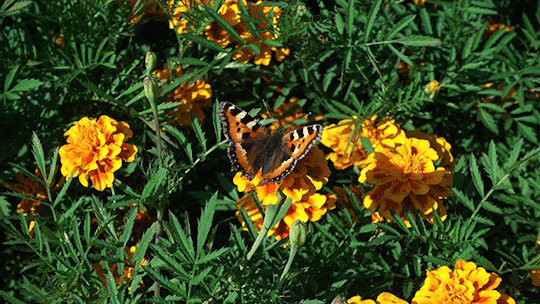
Word Origin: like July, the original name for the month of August was “Sextilis”, which translated to “sixth”. Originally, this month was 29 days, but changed to thirty with the Julius Calendar reform. When Augustus Caesar became the holy Roman Emperor, he took one day from February, and renamed the month “Augustus” in his honor. Instead of renaming September, he renamed August because it directly followed the month of July, which was named after Julius Caesar. Historical names for August include the Irish name “Lúnasa”, which is a version of Lughnasadh, named after the God Lugh. The Japanese name “hatsuki”, the Finnish name “elokuu” (“month of reaping”), the Anglo-Saxon name “Weodmonath” (“vegetation month”), the Frankish name “Aranmanoth” (“corn ears month”), and the Asatru name “Harvest”.
Mythology: the month of August is sacred to the Goddess Hecate, the Greek Goddess of witchcraft, magic, the night, the moon, ghosts, and necromancy. She received her powers over heaven, earth, and sea from her parents the Titan Perses and the nymph Asteria. Hecate is associated with both good and evil, and was feared as well as worshipped by the ancient Greek people. Hecate witnessed the abduction of Persephone by Hades. Because of this knowledge, she went to Persephone’s mother Demeter, and helped search for her with a torch in hand. This myth lead to the creation of pillars called Hecataea, which stood at crossroads and doorways to keep away evil spirits.
Traditions and Folklore: I have given a brief summary of the Goddess Hecate above, and now I will talk about the August rituals that are connected with her. Hecate is a Goddess that is also associated with the harvest, the first of which occurs in the month of August. In pagan thought, it is Hecate who has the power to bestow a bountiful first harvest, or destroy it. August 13th is named “Hecate’s Night” or “Night of Hecate as Goddess of Witches”. This night honors Hecate through ritual and worship. Speaking of the harvest, the major pagan and wiccan sabbat that occurs in the month of August is called Lammas or Lughnasadh, after the Celtic God Lugh. This is the first of the three harvest festivals, the other two being Mabon and Samhain. This was a time of thanksgiving a celebration in the old times, where everyone in the community got together to celebrate the harvest by feasting. There is a superstition surrounding Lammas, where farmers would let the first corn bread go stale and crumble it in the corners of the barn to make sure the harvest lasts through the winter and ensure a bountiful harvest.
Moon: Sturgeon Moon, Barley Moon, Corn Moon, Herb Moon, Wort Moon, Wyrt Moon
Zodiac: Leo, Virgo
Element: Fire, Earth
Gender: Masculine
Sabbat: Lammas/Lughnasadh (August 1st)
Deities: Ganesha, Thoth, Hathor, Diana, Hecate, Nemesis
Animals: Lion, phoenix, sphinx, dragon, Crane, falcon, eagle
Nature Spirits: dryads
Trees: hazel, alder, cedar
Colors: dark green, yellow, gold
Flowers/Herbs: Chamomile, St. Johns wort, bay angelica, fennel, rue, orange, Sunflower, marigold, gladiolus
Crystals: carnelian, emerald, jade, moonstone, peridot, sardonyx, topaz, tourmaline, cat’s eye, jasper, fire agate, diamond, sapphire
Incense: Frankincense, heliotrope
Characteristics, Influences, and Energies: animal magick, abundance, prophecy, prosperity, wisdom, harvest energy, appreciation, vitality, health, friendships
132 notes
·
View notes
Text
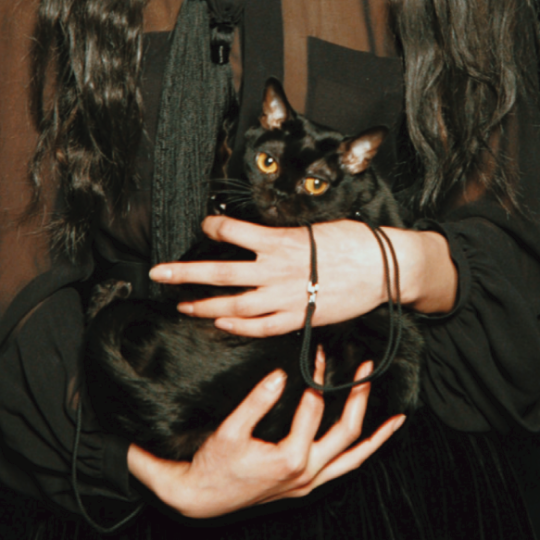


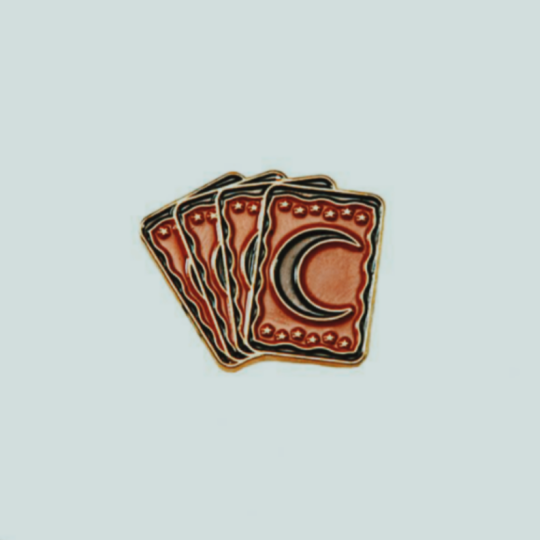

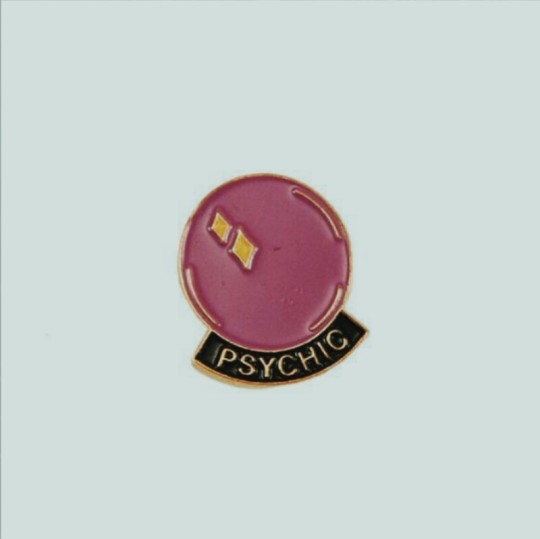



greek myth meme: titanesses (1/5) - hecate
Hecate was the chief goddess presiding over magic and spells. She witnessed the abduction of Demeter’s daughter Persephone to the underworld and, torch in hand, assisted in the search for her. Thus, pillars called Hecataea stood at crossroads and doorways, perhaps to keep away evil spirits. Hecate was represented as single-formed, clad in a long robe, holding burning torches; in later representations she was triple-formed, with three bodies standing back-to-back, probably so that she could look in all directions at once from the crossroads.
#hecate#hekate#modernmythsnet#moodboard#deities#greek myth#aesthetic#my edits#mythedit#mythologyedit#greek mythology#leahsmythfamily#livsmythfam#franzisfamily#femmefatalenet#maddysmythfam#pandysfamily#luizasfamily#gwylllgisfamily#sarismythfam#thebabylonfam#greekmythedit#greek myth meme#mythonetwork#graphics
66 notes
·
View notes
Text
How To Work With The Goddess Of Magic & Necromancy
Hecate become the leader goddess presiding over magic and spells. She witnessed the abduction of Demeter’s daughter Persephone to the underworld and, torch in hand, assisted within the look for her. Thus, pillars referred to as Hecataea stood at crossroads and doors, possibly to keep away evil spirits. Hecate became represented as unmarried-fashioned, clad in a protracted robe, preserving burning torches; in later representations she become triple-fashioned, with 3 our bodies status lower back-to-back, possibly in order that she may want to look in all instructions straight away from the crossroads. She changed into accompanied by means of packs of barking puppies.
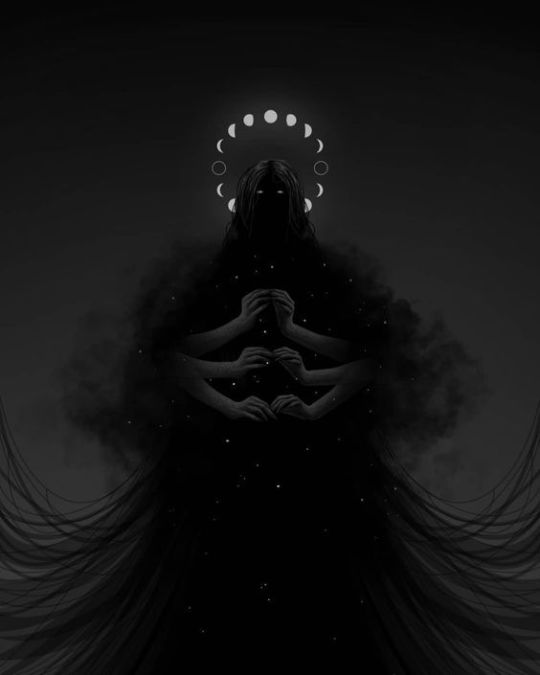
Although humans of all international Hecate locations, eras, and degrees of civilization have evolved myths that explain the existence and workings of herbal phenomena, recount the deeds of gods or heroes, or seek to justify social or political institutions, the myths of the Greeks have remained unequalled in the Western world as assets of ingenious and appealing ideas. Poets and artists from ancient instances to the present have derived suggestion from Greek mythology and feature observed modern-day importance and relevance in Classical mythological themes.
Hecate (Hekate) is a goddess of Greek mythology capable of each proper and evil. She was related to witchcraft, magic, the Moon, doors, and creatures of the night time like hell-hounds and ghosts. Often depicted carrying a torch to remind of her connection with the night time, in sculpture she has 3 faces for her position because the goddess of limitations and the parent of crossroads.
1 note
·
View note
Text
The Sanderson Sisters and The Witching Hour Witches (Hecateae)

I thought I made this post a long time ago but I guess I didn't.
Ever watch Hocus Pocus and think "Boy, those witches look familiar!"
Well, that's because The Sanderson sisters are based on the classic trope (and in some cases, religious icon) of the Maiden, Mother, and Crone.
Though Sarah Sanderson is far from virginal she is clearly the maiden of the group as she is the youngest and most child-like.
Mary is the motherly one.
And Winifred is the eldest and the leader. She is clearly the Crone.
In traditional folklore and witchcraft this is the three-in-one. Maiden, Mother, and Crone and they turn up a lot in witch related pop-culture.
Specifically the comedic version turns up in DC comics horror anthology comics known as The Witching Hour. In the late 60s and 70s DC comics attempted several horror anthology titles similar to EC's Tales from the Crypt. First they added Cain as the punny host of The House of Mystery comics starting at issue 175. Then came The House of Secrets and several others like Tales of Ghost Castle (where the character Lucien started from) and The Witching Hour.
The version of the Hecateae that turn up in The Sandman are the three from The Witching Hour comics and you may notice they are strikingly similar to a certain trio of Disney's bungling witches.
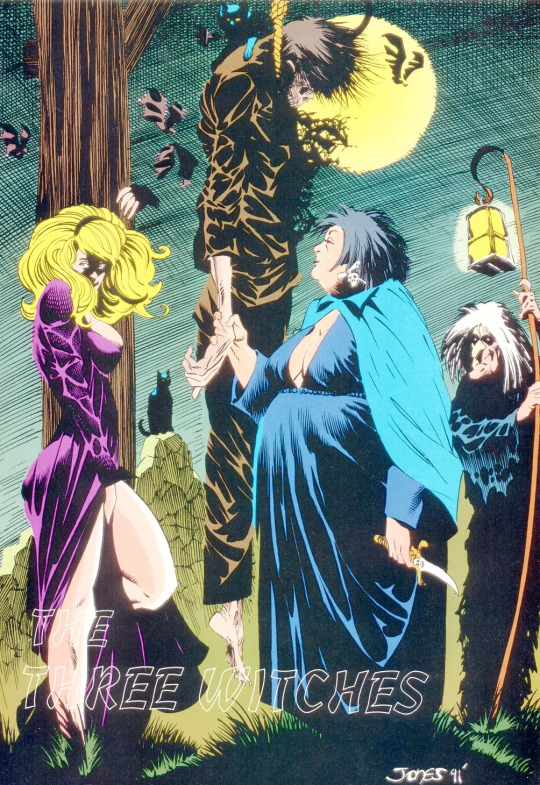
You have the sensual blond version of The Maiden. You have the heavier, black-haired Mother. and then the thinner, more severe faced Crone.
These comical versions were unofficially replicated for the witches of Disney's Hocus Pocus though without obvious credit.
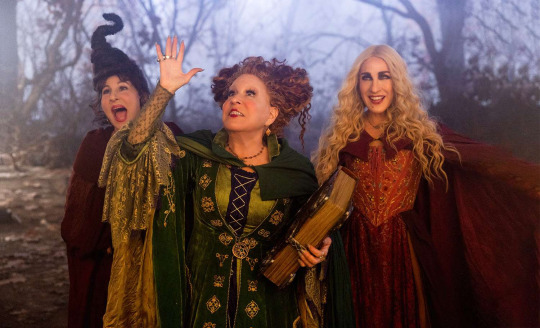
The version of the three-in-one who appear in The Sandman Netflix series don't quite match the horror anthology version from The Witching Hour the way they did in the comics. But you still may at least notice that they are both depictions of the Maiden, Mother, and Crone.
The maiden, Mother, and Crone turn up in a lot of pop culture dating back centuries. But the versions from DC's The Witching Hour (I strongly suspect) had a heavy influence on the look and personalities of The Sanderson Sisters in Disney's Hocus Pocus.
So if you watch Hocus Pocus and think "Gee, those witches seem familiar." That's because they are.
3 notes
·
View notes
Text
So what the Hell does Disney’s Hocus Pocus have to do with The Sandman?
Some people have questioned why I have shared Hocus Pocus content to my “Neil Gaiman’s The Sandman” Facebook group. It’s not just because it is Halloween related and Halloween aesthetics turn up a lot in The Sandman.
It very much all has to do with the Hecate.
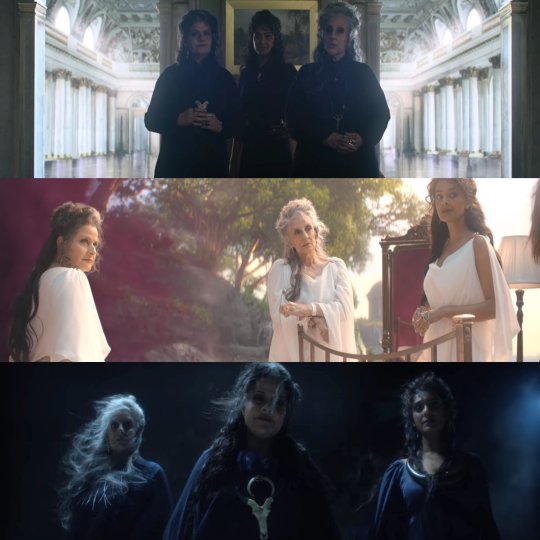
In Neil Gaiman’s The Sandman we have the Three-in-One, the Triple Goddess. Hecataea (goddess(es) of witchcraft and magick, who also doubles as The Fates, and The Furies AKA The Kindly Ones.
Back in 1969 DC Comics introduced “The Three Witches” as the hosts of one of their horror anthology comics. Cain, Abel, Lucien, Eve (The Raven Woman), The Mad Mod Witch (Fashion Thing), Destiny, and The Hecateae all started as hosts for the old horror anthology comics. Cain hosted The House of Mystery. Abel hosted The House of Secrets. Lucien hosted Tales of Ghost Castle and the three Witches (Hecataea) hosted The Witching Hour.
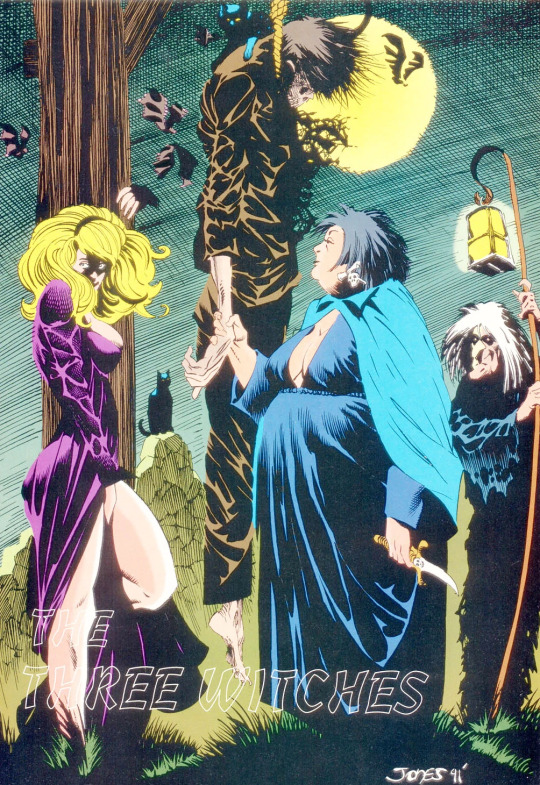
Here the Maiden, Mother, and Crone used the “Modern” names of Cynthia, Mildred, and Mordred. To reaffirm that these are their new names, they tell these names to Morpheus in issue 2 of The Sandman. Cynthia’s look was likely loosely inspired by Sabrina the Teenage Witch.
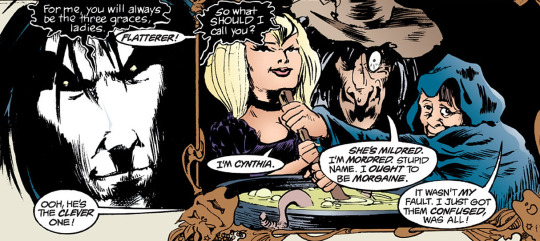
Three witches, or “Weird sisters” was a image popular in literature and folklore soldified thanks to the cultural influences of the likes of William Shakespeare with his own Weird Sisters.
The maiden, Mother, and Crone turn up a lot in pop culture, often unnoticed.
ere are the Wyrd Sisters from Terry Pratchett’s Discworld.
Granny Weatherwax (Crone), Nanny Ogg (Mother), Magrat Garlick (Maiden).
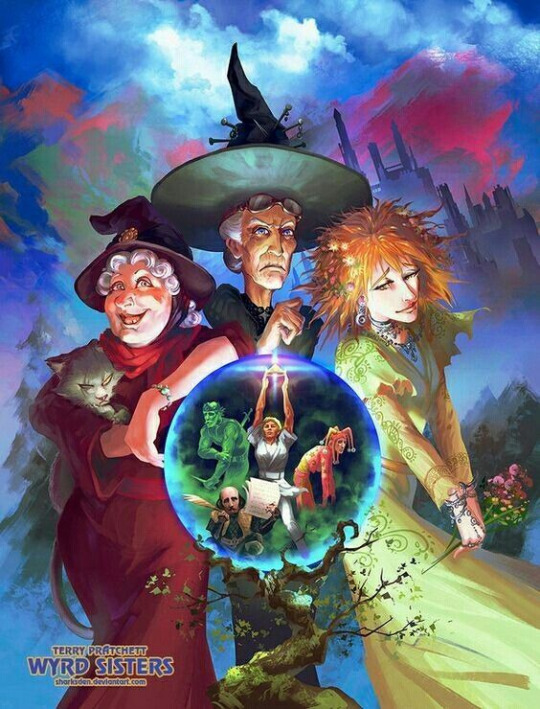
Disney’s Gargoyles The Weird Sisters are Luna, Phoebe, and Selene (a moon theme which is common with the three in one. Waxing, full, and waning.)
Though the age distinction isn’t there it’s still a representation of the Three-in-One. They are never separate and they function as one. They also tend to appear the way they want to be seen or the way people expect them to be. For example, when Demona was looking at them, they were a set of elderly female gargoyles but that is not how MacBeth saw them.
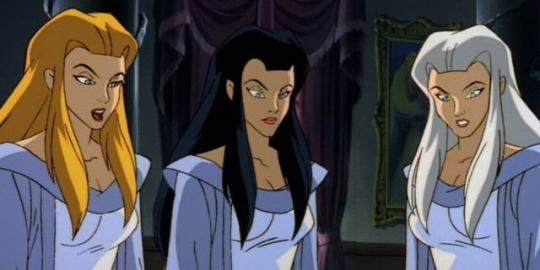
Sabrina and her aunts. This one might be a bit of a stretch but you have three witches who are rarely apart so you have the trifecta and Sabrina, herself, is clearly the maiden. Though the Netflix Chilling Adventures of Sabrina ironically uses the aunts to pay homage to DC”s Cain and Abel I’ll use the sitcom version here.

In the Chilling Adventures of Sabrina The Weird Sisters are literally Prudence, Agatha and Dorcas.
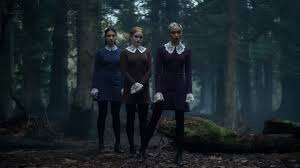
The Addams Family features it, but it might be pure accident. You have Wednesday (Maiden), Morticia (Mother), and Grandmama (Crone).
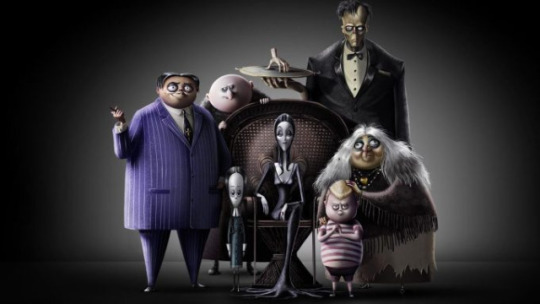
Now we have the Hex Girls from Scooby Doo. I Love this little “Eco Goth” band. Not quite the conventional Maiden / Mother/ Crone however you could argue that Thorn is the Crone in this instance, Dusk is the maiden, and Luna is the mother. I pick these roles for purely superficial reasons here since Dusk has the child-like pigtails and Thorn is clearly the most dominant / leader and I perceive her as the oldest.
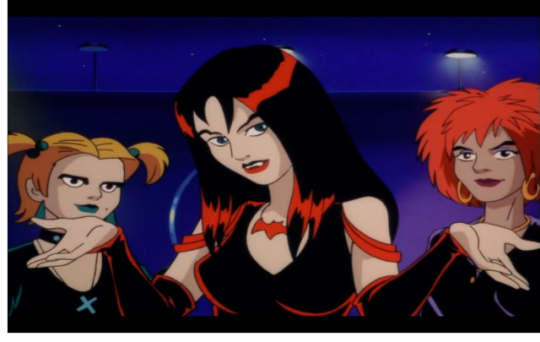
There are the sisters of Charmed. Not quote Maiden / Mother / Crone but definitely meant as a trio of witches who aren’t complete without the others.
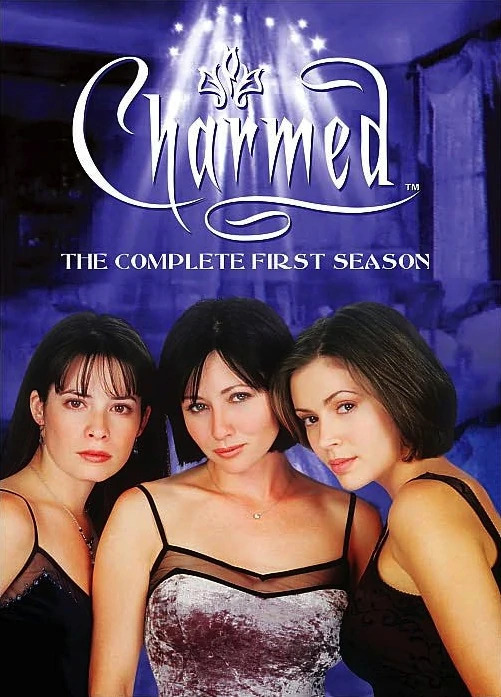
Adelaide (Crone), Auntie Whispers (Mother), and Lorna (Maiden) from Over the Garden Wall. This one is hard to spot until you realize the connection between Adelaide, Auntie Whispers, and Lorna. Once you make the connection and realize the family bond and magick which binds the three you start to see the Maiden / Mother / and Crone aspects in their depictions. Adelaide being the older sister, Auntie Whispers who is the mother figure for Lorne, who is the innocent maiden possessed by an evil spirit.
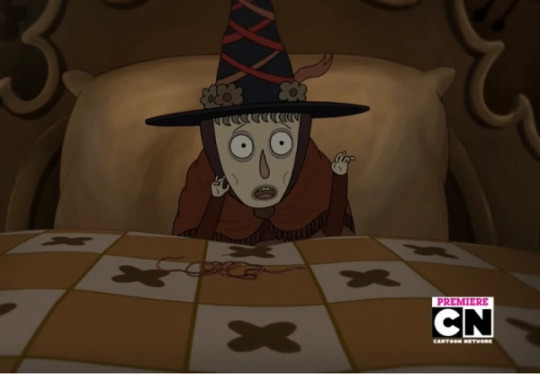
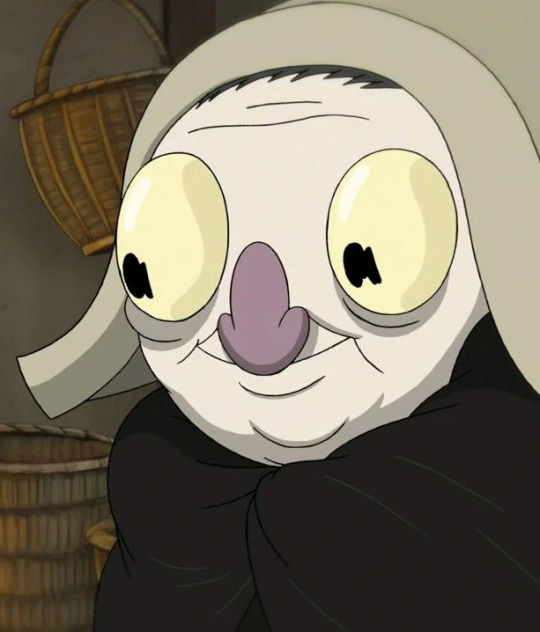

Another trio is The Witches of Eastwick though not quite Maiden, Mother, and Crone, it felt worth a mention.

Marvel attempted it’s own version of “The Witches” with Jennifer Kale, Satana and Topaz.
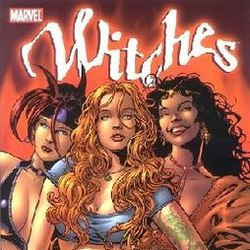
Though speaking of the Virgin Mary one could argue that it was actually a a subversive triple Goddess mention at the end of Goethe’s Faust Part 2. When Faust ascends to Heaven we get this line: (Translation from A. S. Kline)
“Virgin, Mother now, and Queen, Goddess, grant your mercies!“
and
“Here, grows to reality: The indescribable, Here, is done: Woman, eternal, 12110 Beckons us on.“
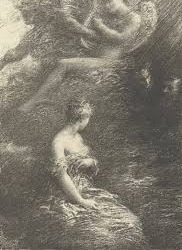
The Norns (Marvel’s depiction of the three Fates).

And now to Hocus Pocus.
In Disney’s Hocus Pocus you have The Sanderson Sisters. A bungling group of witches who feel like they came crawling out of a horror anthology comic book with their antics and dark humor. Sarah is the Maiden, Mary is the Mother, and Winifred, The leader, is obviously the Crone. (Note: Queen is a more polite alternate name for the crone aspect of the traditional three-in-one).
With Hocus Pocus, though I cannot prove it, I strongly suspect The Sanderson Sisters weren’t just inspired by the traditional Maiden, Mother, and Crone, but rather specifically the version from DC’s The Witching Hour comics, which in turn were used as the Hecataea in Neil Gaiman’s The Sandman.
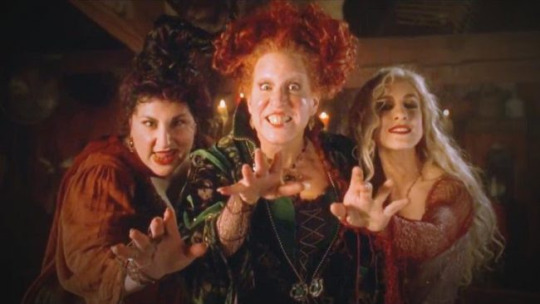
29 notes
·
View notes
Text
Some of the more blatant symbolism in The Sandman
We get so used to looking at The Endless as people with personalities and behavior patterns that it might be easy to forget that they are the embodiment of concepts. Here are some of the symbolic meanings that turned up in The Sandman, particularly with The Sandman: Brief Lives and The Sandman: Overture.
The Sandman: Brief Lives:
In Brief Lives Morpheus has broken up with Thessaly and that’s around the time Delirium decided to pay him a visit. The symbolism here is pretty basic. After a bad break up you could end up with a little delirium (madness / Disorientation).
Then with Delirium (madness / disorientation) Morpheus makes a show of seeking out Destruction but not really putting his heart into it. Many people can act self-destructive after a break up but usually they don’t really mean it.
After that Morpheus makes a more serious effort of seeking Destruction. This is pretty blatant. He seeks destruction. He’s suicidal.
After Morpheus euthanizes his own son, Orpheus, when he steps outside he is met with Delirium and Despair. The emotions of delirium and despair are normal reactions to the loss of a loved one.
The Sandman: Overture:
First, Hope is a child. She may not be the literal embodiment of Hope but she might as well be because the metaphorical purpose is there. Observe:
As the Hecataea allude, sometimes finding Hope is worse than not having any Hope.
Morpheus had hope and lost hope but desire brought him the ghost of hope.
A desire can easily be mistaken for a dream or a desire can become a dream. Sometimes it’s hard to tell the difference between a dream and a desire or the difference is unimportant.
Morpheus lost hope and believes he lives in a universe devoid of hope. And by the time The Sandman started he had forgotten he ever had hope. (No wonder he became suicidal).
It takes dreams working with desire, but most importantly, hope, to save the universe.
Desire walks hand in hand with despair. Often when you desire something that desire is accompanied by despair or the result of despair. Sometimes desire is the cause of despair and sometimes despair is the cause of desire. Desire and despair are twins.
41 notes
·
View notes